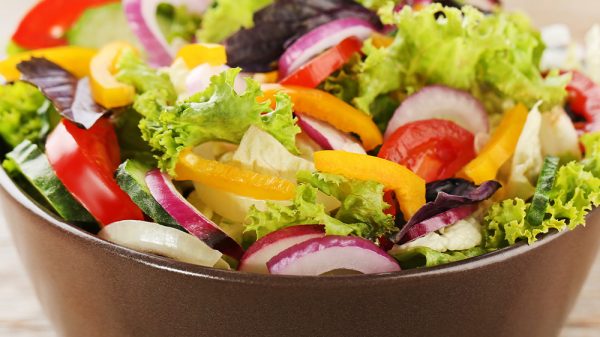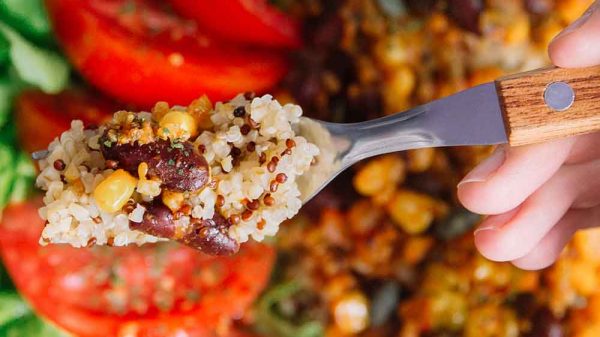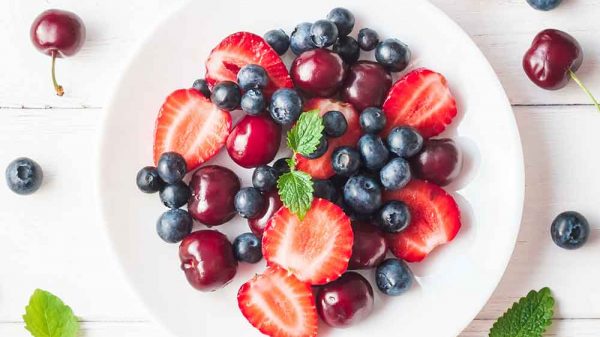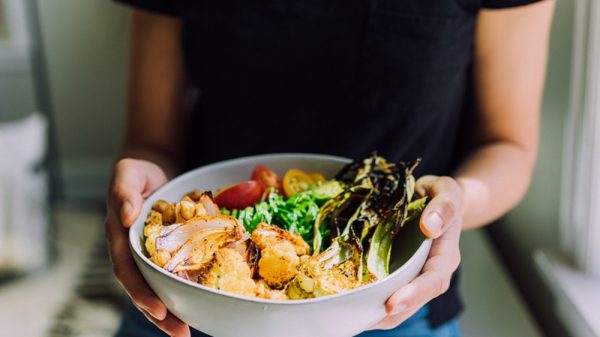If you’ve gone backpacking before, you know that climbing uphill with a pack is hard work. If you’ve planned a backpacking trip, you know that food plays a big part in the planning process. Backpacking is essentially a sustained workout, and it’s an excellent physical exercise to boost your cardiovascular and metabolic health. However, it’s crucial that you choose the best vegan backpacking food to keep you fueled throughout the day. Plus, it’s important for your food to also be lightweight since you’ll be carrying them with you wherever you go.
If you’ve been diagnosed with a metabolic condition like diabetes or fatty liver disease, this doesn’t mean you have to forgo adventurous activities like backpacking and camping. But how do you choose the best backpacking food to keep your energy up and support your health? Plant-based backpacking food is the way to go. Keep reading to find out how to choose and prepare the best vegan backpacking food.
Water
Before we get into backpacking food ideas, let’s talk about water. Being able to hydrate effectively while you’re on the trail is crucial to feeling your best and supporting your body’s metabolic processes. You can get any number of fancy purifying devices and light pens, but good old-fashioned iodine tablets work just as well. Plus, they’re more cost-effective. You can get a set of 50 iodine tablets for around 10 bucks, with each tablet purifying about 1 liter of water. Fifty liters of water are enough to fuel two weeks of hardcore hiking and backpacking.
The Healthiest Backpacking and Camping Food
Just because you’re going camping, that doesn’t mean you have to sacrifice nutritious foods. It’s still possible to eat healthy and reverse metabolic conditions like insulin resistance, high blood pressure, and fatty liver disease while enjoying the outdoors and living an active lifestyle with camping and backpacking.
When aiming to cut meat and dairy out of your diet, it’s actually easier than you might expect to prepare vegan backpacking food and to follow a plant-based diet while in the wilderness.
Vegan Backpacking Recipes for Breakfast, Lunch, and Dinner
It will be helpful to have some pre-packaged vegan items on hand for easy meal preparation. Lots of brands like Harmony House, Good To-Go, and Backpacker’s Pantry offer pre-packaged vegan meals marketed as camping food. Though these are great options, preparing vegan meals yourself is more cost-effective.
Generally, to support metabolic health, preparing your own backpacking recipes is the way to go. When it comes to creating tasty, healthy, convenient vegan meals on the trail, simplicity is the name of the game. We’ve compiled some vegan backpacking food and meal ideas that rely more on whole foods and less on pre-packaged meals.
Best Vegan Breakfasts for Backpackers
1. Oatmeal
Oatmeal can be easily carried in bags and cooked on a camping stove in a pot. You can conveniently carry oats in a plastic bag, however, if the idea of portioning out oatmeal every morning sounds too difficult, an easy oatmeal trick is to purchase low-sugar packets of instant oats. Hot water can be poured directly into the packets and you can eat your oatmeal directly out of the packets.
Preparing overnight oats is another time-saving method for making sure you have a grab-and-go breakfast the next morning. Simply add oats, purified water, and powdered soymilk to a container with dried fruit, nuts, a natural sweetener, and any other ingredients you like. In the morning, simply eat straight out of the container for a hearty breakfast.
2. Breakfast “Shake,” Energy Bar, and Fruit
If you don’t have too much of an appetite in the morning, this breakfast combo is for you. Simply add protein powder or essential amino acid powder to your water or coffee. Combine with a piece of fruit and an energy bar.
3. Low-Sugar Granola
Healthy granola can combine tons of nutrient-dense foods into one product. Choose granola that is made with whole grains like oats as well as nuts, pumpkin seeds, chia seeds, and flax seeds. Steer clear of processed granola that is filled with saturated fat and added sugars. When on the trail, enjoy a big bowl of natural granola with soymilk.
Best Vegan Lunches for Backpackers
When you’re backpacking and camping, breakfast and dinner will likely be the main meals of the day. It’s time-consuming and inconvenient to unpack all of your cooking equipment in the middle of the day to prepare lunch, only to pack it all up again to continue on your way. By saving the camping stove and equipment for after you roll into camp and for breakfast the following morning, you ensure that you only have to unpack and repack once per day.
You can think of camping lunches as amped-up versions of snacks, packed with nutrients and calories to fuel the rest of your day. The best lunchtime vehicle for food on the trail is the whole-grain tortilla.
1. Whole Wheat Tortillas with Peanut Butter and Dried Fruit
Sound like a weird combination? Don’t knock it ‘till you try it! Whole wheat tortillas provide the carbs you need for energy, paired with protein and healthy fats from peanut butter. It’s like a rolled-up version of a peanut butter and jelly sandwich.
2. Beans and Salsa in a Tortilla
Layer beans, salsa, and avocado in a tortilla. Top with nutritional yeast and enjoy.
3. Peanut Butter and Jelly Sandwiches
A classic peanut butter and jelly sandwich or two can be a satisfying lunch when you’re backpacking. Make sure to prepare sandwiches using whole-grain bread that’s packed with fiber.
Vegan Backpacking Food: Best Vegan Dinners for Backpackers
1. Pasta
Whole-grain pasta is the perfect base for a vegan dish. It’s also an extremely versatile ingredient and can be combined with any beans and seasoning of your choice. Try serving your favorite pasta with white beans and top with vegan pesto.
2. Lentils
A sack of dry lentils is one of the best things you can carry with you on the trail. Though all kinds of lentils can be cooked using a camping stove, red lentils take the least amount of time. Season with turmeric, curry, salt, and pepper, and serve with quinoa or rice.
3. Beans and Rice
Beans and rice hits the spot after a long day of hiking and together combine to make a complete protein. Combine your kidney beans, black beans, or chickpeas with rice and sautéed bell peppers, onions, and garlic. Stir well and heat in a pot over the camping stove. Season with taco seasoning, Cajun seasoning, or Italian seasoning.
4. Ramen
Add a package of ramen to boiling water. Ideally, look for ramen that is lower in sodium and doesn’t contain preservatives like MSG. To enhance the antioxidant content, add beans of your choice and bell peppers, and top with avocado.
5. Burritos
Nothing beats a big burrito after a day of hiking. Prepare a batch of instant rice and heat up with black beans. Stir fry bell peppers and onions and combine with rice and beans. Stir and season with taco seasoning
Backpacking and Hiking Snacks
In addition to meals, you’ll want to make sure you have accessible snacks to munch on while on the trail. Try out these handy snacks that are both healthy and filling.
1. Nuts
Nuts provide lots of healthy polyunsaturated fats, anti-inflammatory compounds, protein, and fiber. They’re also calorically dense and perfect to use as a re-fuel on the trail.
2. Rice Cakes
Rice cakes are crunchy, satisfying snacks that can be paired with peanut butter or almond butter.
3. Energy Bars
Energy bars feed the hunger monster fast, so you can get on your way. Look for minimally processed energy bars like Lara bars or Rx bars.
4. Fruits and Vegetables
If the weather is in your favor, you’ll be able to carry fruits and veggies for a couple of days without them spoiling. An apple, orange, carrots, celery, or a banana make healthy fiber-filled, antioxidant-packed trail snacks.
5. Trail Mix
Trail mix gets its name because of how well it functions as a hiking snack. Combine nuts, dried fruit, and a little bit of dark chocolate for a tasty snack that packs a punch of energy and antioxidants to fuel your journey.
Beverages, Supplements, and Medicines
1. Electrolyte Powder or Tablets
As mentioned earlier, staying hydrated on the trail is a top priority. While exercising, you are more prone to dehydration, especially if you’re exercising in hot conditions. Dehydration can lead to symptoms like low blood pressure, lightheadedness, and weakness that you don’t want to be experiencing while you’re in the middle of nowhere.
2. Essential Amino Acid Supplements
The body requires all essential amino acids in optimal amounts to best support muscle synthesis, neurotransmitter synthesis, metabolic processes, and protein production.
In general, the best sources of essential amino acids come from animal products, like dairy and meat. If you’re relying on plant-based sources to get all the essential amino acids you need, it’s crucial to combine several protein sources throughout the day.
Essential amino acids are handy supplements to bring with you while hiking or backpacking and are particularly important to incorporate into your diet if you’re eating primarily plant-based foods. It can be a hassle to assess the amino acid content of plant foods and plan your diet accordingly. To avoid having to plan your proteins while on the trail, an essential amino acid supplement can ensure that you have all the amino acids you need to stay healthy and fit.
Though whey protein is an excellent protein supplement, the body uses individual essential amino acids even more efficiently than whey protein powder, since the process of breaking down proteins into amino acids is circumvented. By adding essential amino acids to your food and drinks while on the trail, you can easily increase your intake of amino acids and boost your muscle growth without having to add extra calories.
3. Coffee and Green Tea
Coffee and green tea can provide a boost of energy in the mornings when you’re on the trail. They are especially useful if you didn’t get a restful night of sleep and need to hit the trail early. Both coffee and tea also have antioxidant properties and show promise for helping lower liver inflammation and reverse fatty liver disease. Freeze-dried coffee is the easiest way to carry coffee on the trail, while you can carry green tea in teabags.
4. Spice Kit and Condiments
Having a mini spice kit and condiments ensures that none of your vegan food has to be flavorless. Good spices to have on hand include turmeric, curry, salt, pepper, and one of your favorite multi-purpose seasonings like an Italian blend, taco seasoning, or Cajun seasoning. Bring mini containers of your favorite condiments, like hot sauce or mustard. Nutritional yeast is a healthy alternative to cheese, can be added to nearly any dish and is packed with B vitamins and protein.
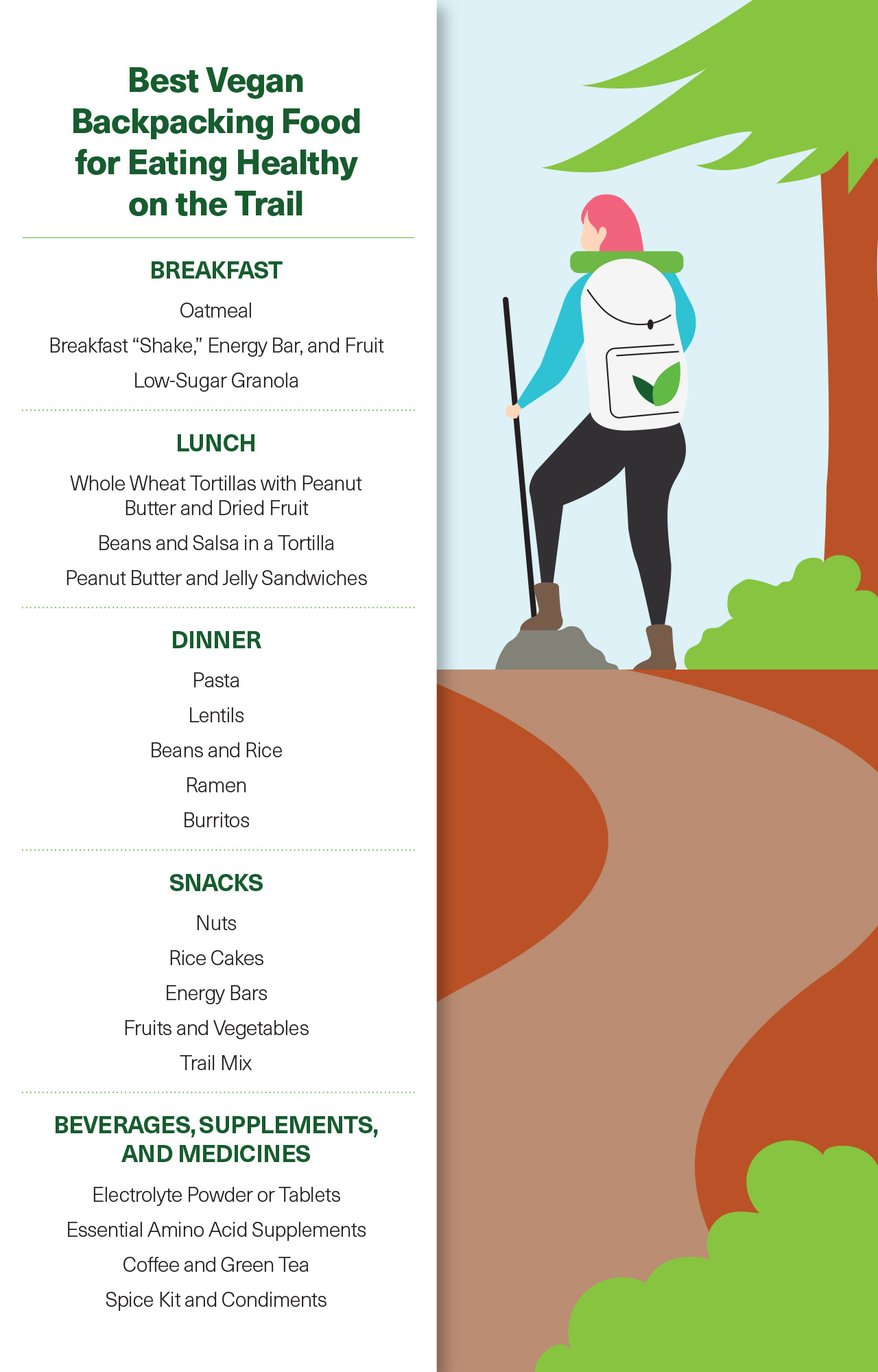
Camping Grocery List of Vegan Backpacking Foods
Here’s a camping food list that is helpful to have on hand when you are stocking up before heading out on your adventure. When preparing your next backpacking trip, pick and choose from this list as you plan meals. Bringing every single thing would weigh down your pack.
Whole Grains
These are a staple of the vegan backpacker’s diet. Make sure to stick mainly to whole grains, instead of processed grains. Whole grains contain more fiber, protein, vitamins, and minerals to support your health while you’re backpacking. If you’re gluten intolerant, stick to gluten-free breads, pastas, and grains.
- Quinoa
- Brown rice
- Couscous
- Millet
- Oats
- Whole-wheat pasta (thinner pasta cooks faster)
- Chickpea pasta
- Lentil pasta
- Whole-grain bread
Nut Butters and Jam
Always have a jar of your favorite nut butter on hand, as well as low-sugar jam for peanut butter and jelly sandwiches.
- Peanut butter
- Almond butter
- Hemp butter
- Raspberry jam
Cooking oil
Just like when cooking on a regular stove, stir-frying vegetables or grains on a dry pan can lead to burned food. Bring a small container of cooking oil for when you use your pan. Good oils for cooking include:
- Olive oil
- Avocado oil
- Grapeseed oil
Condiments
It’s hard to enjoy a meal when it tastes bland. Make sure you bring the spices and condiments on the trail, so you can add flavor to your food. Some examples include:
- Salt and pepper
- Turmeric
- Curry
- Cajun seasoning
- Pesto
- Italian seasoning
- Salsa
- Hummus
- Fajita seasoning
- Taco seasoning
- Cinnamon
- Mustard
- Ketchup
- Hot sauce
- Nutritional yeast
- Natural sweeteners, like erythritol or Stevia
Beans
You can add beans to all kinds of dishes, from a vegetable stir-fry to a burrito. When looking for beans at the grocery store, seek out pre-cooked beans packaged in airtight, light-weight bags. Canned beans quickly add pounds of weight to your backpack.
- Black beans
- Kidney beans
- Chickpeas
- Black-eyed peas
- White beans
- Red beans
- Pinto beans
- Soybeans
- Dried lentils
Fresh Fruits and Veggies
When backpacking, it can be challenging to carry fresh fruits and vegetables in your pack. This is also largely determined by the weather. If you’re hiking in cooler weather, it can be easier to carry fresh fruits and veggies for a couple of days. Resilient fruits and vegetables to add to your shopping list include:
- Apples
- Oranges
- Bananas
- Avocados
- Bell peppers
- Onions
- Garlic
- Carrots
- Celery
- Kale
Dried Fruits and Veggies
When you no longer have a stash of fresh fruits and veggies on hand, dried fruits and veggies come in handy. The dried versions often have the same vitamin, mineral, and antioxidant content as the fresh versions. Try bringing some of these dried produce products on the trail to be used in trail mix, or to be enjoyed plain.
- Raisins
- Dried mangoes
- Dried cherries
- Dried blueberries
- Dried apricots
- Freeze-dried raspberries
- Freeze-dried blueberries
- Dried kale chips
- Dried beet chips
Nuts and Seeds
Nuts and seeds are healthy, nutrient-packed ingredients for trail mix, and also make great snacks by the handful. Choose your favorite nuts to bring backpacking:
- Walnuts
- Peanuts
- Pistachios
- Almonds
- Hazelnuts
- Pumpkin seeds
- Sunflower seeds
Packaged Foods
Though preparing food fresh is always the healthiest method, unpredictable circumstances while backpacking – such as bad weather or illness – can make it nearly impossible to prepare a meal, especially with limited supplies and without the amenities of a modern kitchen. Having pre-prepared vegan options on hand helps reduce stress while you’re in the backcountry. Choose plant-based, minimally processed packaged foods that are low in added sugar, saturated fat, and sodium. Make sure the packaged foods you choose are sealed and stored at room temperature, and not in the refrigerated section.
These vegan foods can be ordered online directly from vendors or from Amazon, and can often be found in local grocery stores:
- Beans and rice
- Chana masala (an Indian dish made with chickpeas, tomatoes, and spices)
- Ramen noodles
- Curried lentils
- Tofu
- Energy bars
- Dark chocolate
- Instant rice, or boil-in-bag rice
- Powdered soymilk
Supplements
Having certain supplements on hand is important for helping prevent dehydration and supporting optimal muscle synthesis and biological functioning.
- Essential amino acid supplements
- Whey protein
- Electrolytes
Equipment You Need to Prepare Backpacking Meals
Having a conventional breakfast, lunch, and dinner can sometimes be tricky when you’re on the trail. If you’re doing a backcountry trip with little or no access to modern amenities, it’s essential to be equipped with everything you need to make a healthy meal in the middle of nowhere. A few essential pieces of camping equipment can help you prepare meals as easily as possible.
1. Camping Stove
If you’re backpacking without access to a kitchen, a small camping stove is crucial. Be sure to bring extra fuel canisters, depending on how long you’ll be in the wilderness.
2. Wind Guard
When you’re hiking and backpacking, it can be difficult to predict weather changes. Especially if you’re hiking in higher altitudes or during the winter season, the weather can often be cold and gusty, making it difficult to keep your camping stove lit. Wind guards are lightweight shields that wrap around your stove and protect the flame from wind, making meal preparation possible.
3. Light-Weight Pot, Pan, Mug, and Bowl
In the backcountry, you won’t have the luxury of a set of dishes and pots and pans. A sturdy, light-weight pot and lid can be used for all of your cooking needs, from boiling water to preparing a stir fry. A small, light-weight pan can be helpful if you have room for another piece of equipment. Similarly, a single bowl can be used as your eating vessel for all foods, from sandwiches to soups. Having a mug on hand is useful for drinking hot beverages or even as a second bowl when needed.
4. Animal-Proof Containers
When you’re camping in the wild, nothing stands between you and the wildlife. So, it’s important to take the necessary precautions to keep yourself and your food at a safe distance from animals.
Always cook and store your food at a safe distance from your campsite. Generally, it’s recommended to keep food approximately 300 feet away. Bear canisters are helpful for storing food and are designed to block the scent of food from animals. It’s also a good idea to keep other possibly scented items like toothpaste and deodorant in the canister overnight as well, in addition to food.
Properly storing your food and scented items lowers the likelihood that unwanted critters are attracted to your tent. If you’re camping in an area that has lots of black bears or grizzly bears, bear canisters are key. Even if you’re camping in an area that’s not known for bears, it’s still a good idea to keep your food in a sealed container to prevent attracting other creatures like raccoons and insects.
5. Multi-Purpose Cutlery
When you’re trying to carry supplies as efficiently as possible, multi-use tools are handy. A “spork” is a combined spoon and fork and can be used as both utensils as well as a stirring utensil when cooking. Additionally, carry along a decent knife for cutting vegetables and other foods.
6. Biodegradable Soap
Even while camping in the middle of nowhere, hygiene is important to avoid growing bacteria and picking up an unwanted bacterial infection. Soaps based on natural products like coconut oil, essential oils, and apple cider vinegar ensure that your dishwashing and bathing practices don’t harm the environment.

Vegan Backpacking Foods: Extra Tips for Backpacking and Planning Meals
1. Consider the Weather
Many times, the weather will dictate what kinds of food you can bring. If it’s winter and it’s likely to be cold most of the time, foods like fresh fruits, veggies, and hummus will last longer on the trail. If you’re dealing with hot, humid weather, sticking to nonperishable food items is the way to go.
2. Consider Your Daily Mileage and Terrain
You want your food intake to fuel you for the day ahead. If you’re planning to cover 15 miles with over half of the mileage heading uphill in higher altitudes, you will need to plan your energy intake accordingly. A long day with uphill mileage will require much more food than hiking a few miles on flat terrain.
3. Stay Connected
Even if your phone has no service in certain areas, keep an emergency radio on hand. Being able to signal for help is important when you’re in remote areas, just in case you face an unexpected emergency situation.
4. Leave No Trace Practices
To leave the nature and wildlife as pristine as you found it, and make sure to carry your trash items in a bag so that when you return to civilization, you can put them in a waste bin.
Conclusion
Backpacking is a freeing experience, helping you clear your mind and get in touch with nature. At the same time, backpacking is an excellent way to improve your cardiovascular health and metabolic functioning. Eating vegan backpacking foods while on the trail helps boost your energy and encourage optimal health. Vegan food on the trail doesn’t have to be bland! Experiment with vegan camping food ideas to find your favorite combinations of flavors and ingredients.
